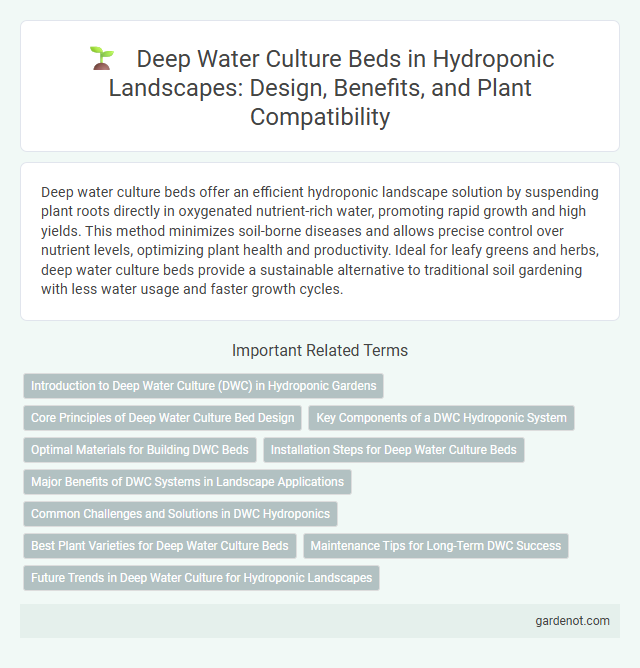Deep water culture beds offer an efficient hydroponic landscape solution by suspending plant roots directly in oxygenated nutrient-rich water, promoting rapid growth and high yields. This method minimizes soil-borne diseases and allows precise control over nutrient levels, optimizing plant health and productivity. Ideal for leafy greens and herbs, deep water culture beds provide a sustainable alternative to traditional soil gardening with less water usage and faster growth cycles.
Introduction to Deep Water Culture (DWC) in Hydroponic Gardens
Deep Water Culture (DWC) is a hydroponic system where plant roots are suspended in oxygen-rich nutrient solution, promoting rapid growth and high yields. This method eliminates soil and provides constant access to water, oxygen, and nutrients directly to the root zone. DWC is widely used in hydroponic gardens for its simplicity, efficiency, and ability to support large-scale leafy greens and herbs production.
Core Principles of Deep Water Culture Bed Design
Deep water culture bed design centers on maintaining optimal oxygen levels in the nutrient-rich water to support robust root development and plant growth. A properly engineered system requires a sturdy, non-toxic container with airtight sealing to prevent contamination and water loss. Consistent aeration through air stones or diffusers ensures dissolved oxygen remains high, while precise nutrient concentration and pH balance are critical to maximizing absorption and crop yield.
Key Components of a DWC Hydroponic System
A Deep Water Culture (DWC) hydroponic system includes essential components such as an oxygen pump, air stones, a nutrient reservoir, and net pots with growing media. The oxygen pump continuously supplies air to the roots through air stones, ensuring optimal oxygenation in the nutrient-rich water reservoir. Net pots hold plants securely while allowing roots to dangle freely in the oxygenated nutrient solution, promoting faster growth and nutrient uptake.
Optimal Materials for Building DWC Beds
Optimal materials for building Deep Water Culture (DWC) beds include food-grade polyethylene and high-density polypropylene, which offer durability, chemical resistance, and safety for plant growth. Using opaque materials helps prevent algae growth by blocking sunlight exposure to the nutrient solution. Incorporating UV-resistant coatings further extends the lifespan of the bed by minimizing degradation from sunlight exposure in outdoor hydroponic systems.
Installation Steps for Deep Water Culture Beds
Installing a deep water culture (DWC) bed begins with selecting a sturdy, non-toxic container that can hold nutrient-rich water and support net pots. After drilling appropriate holes for net pots in the lid, position an air pump and air stones to oxygenate the water continuously, preventing root rot and promoting healthy plant growth. Finally, fill the container with a balanced hydroponic nutrient solution, adjust pH levels to between 5.5 and 6.5, and place seedlings in net pots to initiate the hydroponic cycle.
Major Benefits of DWC Systems in Landscape Applications
Deep Water Culture (DWC) systems offer superior oxygenation for plant roots, resulting in faster growth rates and higher yields in landscaping projects. The constant nutrient-rich water environment reduces soil-borne diseases and pest infestations, promoting healthier, more vibrant plants. DWC beds also enable efficient space utilization and water conservation, making them ideal for sustainable and urban landscape applications.
Common Challenges and Solutions in DWC Hydroponics
Deep water culture (DWC) hydroponics faces common challenges such as oxygen depletion, root diseases, and nutrient imbalances that can stunt plant growth. Solutions include maintaining optimal dissolved oxygen levels using air stones or oxygenators, implementing regular water quality monitoring to prevent pathogen build-up, and adjusting nutrient concentrations precisely for crop-specific requirements. Properly managed aeration and sanitation protocols are essential for sustaining healthy root systems and maximizing yield in DWC hydroponic landscapes.
Best Plant Varieties for Deep Water Culture Beds
Lettuce, spinach, and Swiss chard thrive in deep water culture beds due to their rapid growth and minimal nutrient demands. Herbs such as basil, mint, and cilantro also perform exceptionally well by absorbing nutrients efficiently in oxygen-rich water. Fruiting plants like strawberries and cherry tomatoes require careful oxygenation but can yield high-quality produce with proper management.
Maintenance Tips for Long-Term DWC Success
Maintain optimal oxygen levels in Deep Water Culture (DWC) beds by regularly checking air stones and air pumps to prevent root rot and promote healthy plant growth. Monitor water temperature consistently, keeping it between 65-75degF to ensure nutrient uptake and microbial balance in the hydroponic solution. Change the nutrient solution every 1-2 weeks to prevent nutrient imbalances and reduce the risk of algae growth and disease in the system.
Future Trends in Deep Water Culture for Hydroponic Landscapes
Advancements in Deep Water Culture (DWC) for hydroponic landscapes emphasize automation and AI-driven nutrient management, enhancing plant growth efficiency and resource conservation. Emerging materials for DWC beds improve durability and bio-compatibility, supporting sustainable urban agriculture. Integration with IoT sensors enables real-time monitoring and precise environmental adjustments, driving innovation in hydroponic landscape design.
Deep water culture bed Infographic

 gardenot.com
gardenot.com